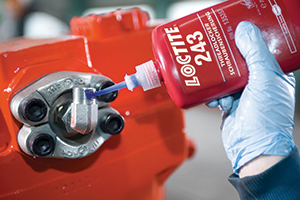
Posted to News on 24th Nov 2020, 00:00
Prevent nuts and bolts self-loosening
When threaded bolts, screws and nuts come loose, it can not only compromise the performance of your mechanical equipment but could also pose a safety risk. we asked the experts at Henkel about options to prevent self-loosening.

Generally, the reason threaded assemblies fail is through loss of bolt tension, the main causes of which are relaxation and self-loosening. Self-loosening is caused by any type of dynamic load, such as vibration or changes in temperature, insufficient clamp load and poorly fitting parts. These load changes lead to short-term frictionless situations where the bolt unwinds from the nut. The sum of these very small movements ultimately results in the loosening of the threaded assembly.
There are several different methods of addressing the issue of vibrational self-loosening. Most of them include the use of additional mechanical devices to lock the threaded assembly and maintain the desired clamp load.
Split washers are one of the most common mechanical devices used for this purpose. The washer is squashed flat when the nut is tightened against mounting surface so that its sharp edges dig in to prevent the threaded fastener unwinding. But while it might delay the length of time it takes for the bolt to loosen, but it will not permanently prevent it.
The main reason is that the split washer does not solve the gapping issue, the free space remaining between the threads of the nut and the bolt. Additionally, being metal itself, a split washer can cause damage to contact faces and corrode in place.
Another common solution is a double nut. While the second nut does increase the surface of interfaced threads, it does not eliminate the gaps between them, and the loosening will still inevitably happen. The additional nut also doubles the amount of surface that can corrode – and that’s a nasty surprise when you come to dismantle the piece. Out of all the mechanical locking devices, the nuts are also the heaviest, and if you use several double nuts to secure your bolts, you’re adding more weight.
The only way to address the gap issue is to use a liquid thread locker which completely fills the gap between the threads. This is an engineering adhesive that solidifies into a tough thermoset plastic between the two metal surfaces in the absence of air and prevents any side to side movement.
Secured in this way, the bolt will be completely vibration proof and stay in place forever – if that’s what you want. If not, the assembly can be easily dismantled with hand tools, for repair or maintenance. Additionally, liquid thread lockers will seal the threads from humidity penetration and, in that way, prevent corrosion.
Correct selection
There is now a huge range of thread locking adhesives available, offering differences in viscosity, strength, temperature resistance, cure speed and harness/flexibility. To determine the best one for the job ask yourself three main questions: What’s the fastener size? Which strength do I need? And how frequently will the assembly need to be serviced?
Typically, on smaller size fasteners, lower strength grades will work well enough regardless of what kind of vibrational loads they may be subjected to. Also, if you have a high servicing frequency requirement, you’ll want to use a lower strength grade as well. For assemblies that get dismantled less frequently, a medium strength product is recommended. It’s also possible to secure a threaded assembly that has already been assembled, using a formula with wicking properties that will creep into the assembly and between the already torqued threads.






